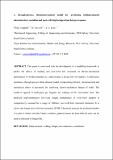| dc.contributor.author | Mac Ardghail, Padraig | |
| dc.contributor.author | Harrison, Noel M. | |
| dc.contributor.author | Leen, Sean B. | |
| dc.date.accessioned | 2019-11-29T14:18:13Z | |
| dc.date.issued | 2018-02-11 | |
| dc.identifier.citation | Mac Ardghail, P., Harrison, N., & Leen, S. B. (2018). A through-process, thermomechanical model for predicting welding-induced microstructure evolution and post-weld high-temperature fatigue response. International Journal of Fatigue, 112, 216-232. doi: https://doi.org/10.1016/j.ijfatigue.2018.02.015 | en_IE |
| dc.identifier.issn | 0142-1123 | |
| dc.identifier.uri | http://hdl.handle.net/10379/15596 | |
| dc.description.abstract | This paper is concerned with the development of a modelling framework to predict the effects of welding and post-weld heat treatment on thereto-mechanical performance of welded material, as a step towards a design tool for industry. A dislocation mechanics, through-process finite element model, incorporating thermal, micro structural and mechanical effects is presented, for predicting thereto-mechanical fatigue of welds. The model is applied to multi-pass gas tungsten arc welding of 9Cr martensitic steel. The predicted high-temperature low cycle fatigue performance of cross-weld samples is comparatively assessed for a range of different post-weld heat treatment durations. It is shown that longer post-weld heat-treatment (PWHT) durations increase the predicted number of cycles to failure and that Vickers hardness gradient across the heat-affected zone can be used as an indicator of fatigue life. | en_IE |
| dc.description.sponsorship | This research is funded by Science Foundation Ireland grant number SFI/14/IA/2604. The authors would like to acknowledge the contributors to this research; NUI Galway, the Ryan Institute, General Electric (UK), ESB International, University of Limerick, Imperial College, London and Fraunhofer IWM, Freiburg. | en_IE |
| dc.format | application/pdf | en_IE |
| dc.language.iso | en | en_IE |
| dc.publisher | Elsevier | en_IE |
| dc.relation.ispartof | International Journal Of Fatigue | en |
| dc.rights | Attribution-NonCommercial-NoDerivs 3.0 Ireland | |
| dc.rights.uri | https://creativecommons.org/licenses/by-nc-nd/3.0/ie/ | |
| dc.subject | Finite-element | en_IE |
| dc.subject | Welding | en_IE |
| dc.subject | Fatigue | en_IE |
| dc.subject | Microstructure | en_IE |
| dc.subject | Constitutive | en_IE |
| dc.subject | POWER-PLANT STEELS | en_IE |
| dc.subject | RESIDUAL-STRESS | en_IE |
| dc.subject | IV FRACTURE | en_IE |
| dc.subject | SIMULATION | en_IE |
| dc.subject | SUPPRESSION | en_IE |
| dc.subject | JOINTS | en_IE |
| dc.subject | FIELD | en_IE |
| dc.subject | PIPE | en_IE |
| dc.title | A through-process, thermomechanical model for predicting welding-induced microstructure evolution and post-weld high-temperature fatigue response | en_IE |
| dc.type | Article | en_IE |
| dc.date.updated | 2019-11-26T17:22:55Z | |
| dc.identifier.doi | 10.1016/j.ijfatigue.2018.02.015 | |
| dc.local.publishedsource | https://doi.org/10.1016/j.ijfatigue.2018.02.015 | en_IE |
| dc.description.peer-reviewed | peer-reviewed | |
| dc.contributor.funder | Science Foundation Ireland | en_IE |
| dc.description.embargo | 2020-02-11 | |
| dc.internal.rssid | 14548916 | |
| dc.local.contact | Sean Leen, Mechanical & Biomedical Eng, Eng-2051, New Engineering Building, Nui Galway. 5955 Email: sean.leen@nuigalway.ie | |
| dc.local.copyrightchecked | Yes | |
| dc.local.version | ACCEPTED | |
| dcterms.project | info:eu-repo/grantAgreement/SFI/SFI Investigator Programme/14/IA/2604/IE/Multi-scale, Through-process Chracterisation for Innovative Manufacture of Next-generation Welded Connections (MECHANNICS)/ | en_IE |
| nui.item.downloads | 463 | |


